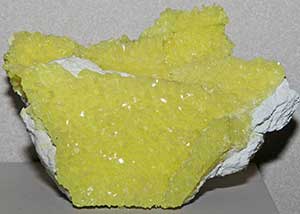 |
| Sulfur - S. |
 |
|
Sulfur crystals produced from volcanic gases seeping out of the ground at
the Kilauea volcano, Hawaii.
|
Sulfur is of importance to every sector of the world's industrial and fertilizer complexes. Sulfur is used as an industrial raw material through its major derivative, sulfuric acid. Sulfuric acid production is the major end use for sulfur. Most sulfur goes into fertilizer; oil refining is another major use as well as a source of sulfur. Consumption of sulfuric acid has been regarded as one of the best indexes of a nation's industrial development. More sulfuric acid is produced in the United States every year than any other chemical. Sulfur is no longer mined in the United States because low-cost sulfur is available as an environmentally mandated (Clean Air Act) byproduct of natural gas processing and oil refining. Similarly, sulfuric acid is produced as a byproduct in metal smelters. Canada and the United States each produce about one-sixth of the world's sulfur.
Background
The bright, lemon yellow, non-metallic element, sulfur, is a very soft mineral. It is only 2 on Moh's scale of hardness. Sulfur was determined to be an element in 1809. Sulfur has a very low thermal conductivity meaning it cannot transfer heat very well. The touch of a hand will cause a sulfur crystal to crack because the crystal's surface warms faster than the interior. Sulfur melts at 108 degrees Celsius, and burns easily with a blue flame. Even the flame of a match is enough to set sulfur on fire. When sulfur is burned it combines with oxygen producing sulfur dioxide, SO2, which smells like rotten eggs.
Sulfur attaches to metal ions, creating a number of significant sulfide ore minerals such as galena (lead sulfide), pyrite (iron sulfide), chalcocite (copper sulfide), and sphalerite (zinc sulfide).
Sulfur easily attaches to oxygen, creating the sulfate ion (SO4). Sulfates are another significant group of minerals, some of which are important commodities. Gypsum (hydrous calcium sulfate) and barite (barium sulfate) are two commodities that include sulfur.
In the late 1800's, Herman Frasch developed a process for removing sulfur from underground deposits. This is still known as the Frasch process. In this process, hot water is forced into the sulfur deposit. The sulfur melts and is pushed to the surface where it is collected and allowed to cool and solidify, or shipped in molten form.
Name
Sulfur (also spelled sulphur) is derived from the Latin name for this element, sulphurium. It means "burning stone" in reference to its source from volcanoes and that it burns so easily.
Sources
Mined sulfur is mostly from salt domes or bedded deposits. The vast majority is produced as a by-product of oil refining and natural gas processing.
Uses
The majority of the sulfur produced in the United States is used to make sulfuric acid. Sulfuric acid has multiple uses in the production of chemicals, petroleum products and a wide range of other industrial applications. Sulfur's main use is in making chemicals for agriculture, mostly for fertilizers. Other uses of sulfur include refining petroleum, metal mining, and the production of organic and inorganic chemicals. A multitude of products (such as the production of rubber for automobile tires) require sulfur in one form or another during some stage of their manufacture.
Substitutes and Alternative Sources
There are no good alternatives for sulfur. Fortunately, the variety of sulfur resources in different fossil fuel deposits, as well as the large amount of sulfur contained in sedimentary gypsum, guarantees massive sulfur resources for future use. It is estimated that there are 600 billion tons of sulfur contained in oil shale, coal, and other sediments rich in organic matter but a cost-effective method of retrieving the sulfur has not yet been developed. The sulfur available in gypsum and anhydrite is described as being "limitless."